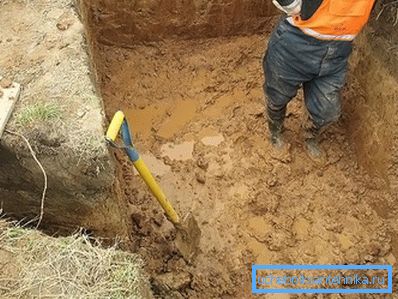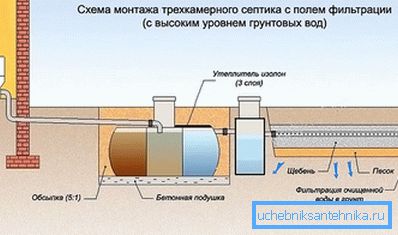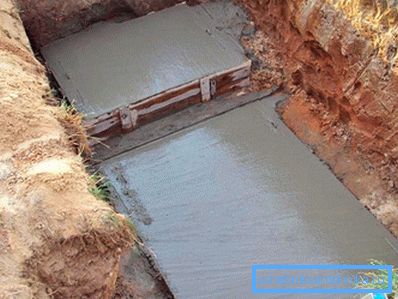Septic tank for high groundwater itself
Striving for country living in comfortable, civilized conditions is a natural desire of people. Modern materials and construction technologies allow building comfortable low-cost housing not only in populated areas, but also in summer cottages and horticultural settlements. At the same time, the solution of the issue of utilization of domestic and sewage wastewater requires a special approach. Few people are satisfied with the usual cesspool and amenities on the street. Centralized sewerage engineering networks are the exception rather than the rule in suburban settlements. A septic tank for a dacha and a village house solves the problem of wastewater disposal, as well as maintaining the ecological balance on the site. It is important to consider the level of groundwater occurrence - sometimes you have to make a septic tank for high groundwater with your own hands.
Ground water level
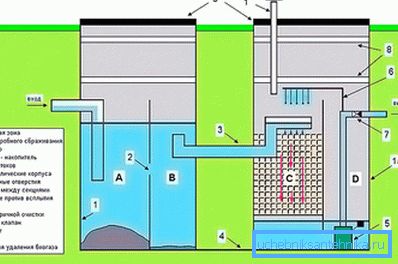
During the construction of a country house and the installation of a sewage disposal system, engineering surveys are carried out to determine the composition and freezing of the soil, the level of groundwater.
If the groundwater level is 2 m or less, there is a high likelihood of a septic tank emerging in the summer and squeezing out when the soil swells in the winter.
Installing a septic tank for high groundwater with your own hands is not so difficult. To know how to make a system of autonomous sewage reliable, environmentally friendly and efficient, you need to understand what problems arise when a high level of groundwater.
High groundwater levels can lead to the following situations:
- Squeezing the septic tank to the surface at any time.
- Full flooding of the septic tank and the ingress of groundwater into the interior, as a result of which the frequency of emptying of the septic tank with the help of an ascenisation machine will increase, and the cleaning and disposal system may be damaged.
- Constant movement of groundwater during a leaky septic tank will spread sewage around, leading to pollution of the environment, as well as sources of drinking water supply.
- The need to set up aeration fields at a higher level.
In order to avoid problems with autonomous sewage in the future, you need to purchase a fully sealed septic tank, which can be securely fixed in the ground.
Choosing a septic tank to give
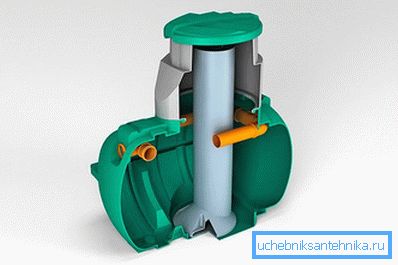
In conditions of high groundwater level, the choice of a device for sewerage system is limited. Fulfillment of the main tightness requirement is possible through the use of special industrial septic tanks, which have several compartments for filtering and cleaning in one unit. They can be made of plastic or metal. The performance of an autonomous sewer system depends on the number of people living in a country house. Industrial models are not cheap, but they are more efficient and have a long service life.
The budget option would be to use as a septic tank of Eurocubes. They can be protected with a metal grill to prevent damage. From several eurocubes you can design a system with separate sections for filtering and settling of waste. For the withdrawal of treated water, a special aeration system is constructed above the groundwater level.
Installation

There are two fundamentally different ways to install a septic tank: on the surface and in the ground. When installing a septic tank on the surface, there is no need to carry out labor-intensive processes for digging the pit, and the problems of high groundwater levels are almost completely eliminated. This option has its drawbacks. The septic tank takes place on the surface and it is necessary to solve the problem of thermal insulation in the winter period.
Installing a septic tank in the ground has some features and is performed in several stages:
- A pit or pit is dug under the chosen construction with a margin in depth and perimeter, as well as trenches for sewer pipes.
- A concrete slab with a thickness of 10–20 cm is poured on a cushion of rubble, gravel or sand with a thickness of 30 cm.
- The septic tank falls on a concrete basis. It must be set to level, and then hold and connect all the pipes.
- Septic tank (eurocubes) attached with straps to the concrete slab, securing anchors.
- Seal all connections of pipes and septic tank.
- Arranged filtration field for the withdrawal of treated wastewater into the soil. To do this, pour a pillow of sand, gravel and rubble above the level of wastewater. On top of the pipe is removed from the tank with treated drains. If the groundwater level is very close to the surface, the aeration field is arranged above the surface, and the wastewater is pumped out with a pump.
- The septic tank is filled with sand.
With constant high groundwater, the installation of an autonomous sewage system can be difficult due to water accumulating in the trench.
In this case, water is constantly pumped out using a drainage pump, and trenches are dug around the perimeter of the excavation bottom so that the area of the site where the pillow will tripled and the stove is poured is without water.
Installing a septic tank to give a laborious process. High-quality installation of the autonomous system is completely within the power of every person, subject to compliance with the technology.
Video
This video shows schematically how to install a septic tank in a soil with a high groundwater level, gives detailed recommendations for installing an independent sewage system:
A photo
